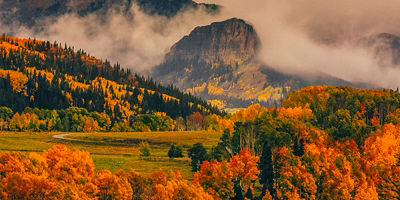
America’s newest national park sits within a day’s drive of the East Coast’s biggest cities, offering millions of adventurers a new playground in their relative backyard. Not that there’s anything particularly “new” about this park (other than its status). The New River is actually one of the oldest rivers in the world, carving a dent into the Southern Appalachians for the last 300 million years. The New River Gorge, which runs for 53 miles and reaches depths of 1,000 feet, has even been protected by the National Park Service since 1978 as a National River, but the 72,000-acre unit was upgraded to a full-fledged park and preserve early in 2021.
With the new status comes new attention. And all of that attention is well-deserved because the New River Gorge is stunning, whether you’re looking for a scenic drive or a heart-pumping adventure. At the heart of the new park is the river itself, which offers more than 50 miles of whitewater with sections that range from “family friendly” to “wild and wonderful.” Meanwhile, tall sandstone cliffs rise from the water, attracting climbers who have established more than 1,500 routes over the last few decades. More than 100 miles of hiking trails surround the gorge and mountain biking is even allowed on certain sections of the trail system. Unlike many national park units, which center around hiking through pristine landscapes, the New River Gorge National Park is truly about the adventure.
The Human History of the New River Gorge
Forget about the national park ideal of protecting a pristine wilderness, the New River Gorge shows many signs and scars of its inhabitants. The oldest artifacts found in the gorge are 11,000-year-old Clovis points used by Paleoindian nomadic hunter/gatherers as spearheads to hunt mammoth and mastodon. Their offspring settled in the area and lived in primitive villages for thousands of years, the ancestors of the Cherokee and Shawnee tribes that would live and hunt in and around the gorge by the time European settlers started poking around. The New River Gorge was considered the western edge of the frontier in the 1600s, when rugged fur traders traversed its slopes.
Later, the town of Fayetteville, W.V., which sits on the rim of the gorge, was battled over four separate times during the Civil War. But things didn’t really pick up until coal was discovered in the late 1800s. Once the C&O Railroad was built, a wave of immigrant labor began flooding the area and a steady stream of coal began leaving. At one time in the late 1800s and early 1900s, the New River supported more than 60 individual coal towns. Most of those coal companies paid its workers in their own individual script, which was useless outside of the company store. Miners fought for decades for better pay and working conditions, to varying degrees of success, but eventually the coal ran dry and the mining towns dwindled through the first half of the 20th century until the last of them shuttered in the early ’60s. Fortunately, some adventurous paddlers discovered the rapids of the New in the same decade and founded rafting companies that carried guests down the New’s Class IV-V whitewater. Rafting boomed and climbing picked up in the ’80s and ’90s.
The New River Gorge’s popularity has only grown over the decades. It has become a haven of multi-sport adventure, boasting more than 1,500 established climbing routes (not to mention countless bouldering problems), rapids that are now etched in whitewater lore and a burgeoning mountain bike trail system. Adventure companies have sprouted expansive campuses just outside the park, offering guided trips and on-site adventures with lodging digs that range from primitive campsites to deluxe homes. The American Alpine Club operates one of its few campgrounds next to the gorge, and Fayetteville, the “western outpost” that both sides of the Civil War battled over, is now a bustling trail town.
Visiting the National Park
New River Gorge National Park is within a day’s drive of some of the most densely populated cities on the East Coast. While some parks in the national park system have moved to a reservation system to handle crowds, accessing the New requires no reservation. There is also no fee charged to enter the park. Depending on the season, you will likely find crowds at popular trailheads or climbing crags. Showing up midweek is always your best bet if you’re looking for solitude.






















